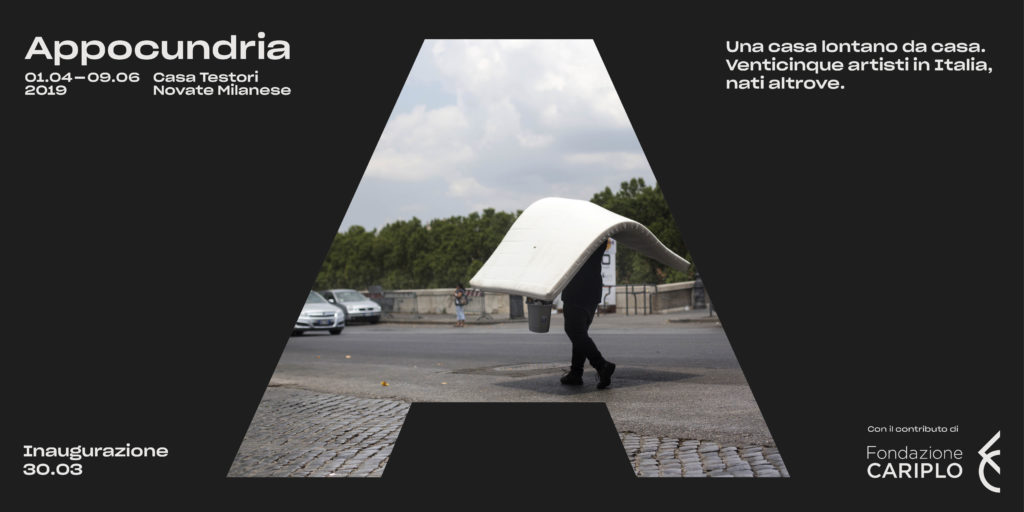APPOCUNDRIA
Curated by Marta Cereda
Casa Testori
1 April – 9 June 2019

APPOCUNDRIA / AN INTRODUCTION
Marta Cereda
Translation of the word saudade is often avoided. The term derives from Lusitanian culture, passing from Galicia through Portugal to Brazil. It describes a form of melancholy, a feeling similar to nostalgia. Its exact definition is uncertain; an equivalent has been sought in the German word Sehnsucht and has been found in one of the Italian dialects. Saudade is close to the Neapolitan term appocundria, which embraces in part that sense of deep melancholy of the soul evoked by the Portuguese word. Appocundria is here an investigation into the definition and sensation of saudade as experienced by a series of artists who emigrated to Italy from their native lands for personal, political, economic, social and family reasons.
Not all of them necessarily take their own autobiographical circumstances into account in their research. Appocundria does not aim at easy rhetoric, but rather a reflection that starts from a personal story which nevertheless has a universal application.
In the research of the artists involved, in fact, this feeling, which goes beyond temporal and spatial frontiers, emerging in different ways. In many cases, for example, the new life intertwines with news arriving from the country of origin, creating a mechanism of constant doubling that leads to the construction of a new identity. In other cases, attention is concentrated on awareness that a return is impossible, whether due to circumstances or to a personal decision, on the increasing distance and on the geographical, cultural or linguistic gap. For others again, research into their own archives and those of others becomes a tool for conserving and recovering their memories.
The idea of Appocundria is inevitably linked to the notion of home and to the need or the decision to build one’s home in a country distant from that of one’s birth. In what way does one carry one’s own home with one? Can you reconstruct it in a foreign country? What do you bring with you? What do you leave behind? How do you create a new memory, one that alters even the past? How can you represent this dimension in an exhibition space that was once, in its turn, another person’s home?
The project takes as its starting point, in fact, an awareness of the unbreakable connotations of Casa Testori as a house and a home. Giovanni Testori’s words and his relationship with this space are therefore the first example of appocundria.
“Nevertheless, I can assure you that what has always helped me to live and, still more, to accept life in spite of all its curses, has always been the return home. One makes these forays into the outside world – which may even be violent, destructive – but in the end the return home lends an ineffable warmth to the very experience of those forays. For returning does not mean forgetting, nor does it mean shedding the violence and destruction.”
For this reason, the exhibition itinerary foresees a constant renewal of influences, a fluidity of movement, a rhythmic coming and going, with the work of the same artist reappearing at different moments and in different spaces.
Starting from the original function of Casa Testori, Appocundria takes the opportunity to consider and ponder today’s migratory phenomena. It is by no chance, therefore, that the exhibition was mounted to coincide with the leap in the darkness caused by Brexit. The date of inauguration, 30 March 2019, was chosen to coincide with the exit of the United Kingdom from the European Union, originally planned for the previous day.
The project is subdivided in three chapters since, alongside the principal exhibition held in the rooms of the villa in Novate Milanese, Appocundria had two appendices outside the house and, indeed, in other homes: a flat in Piazzale Selinunte, Milan and, in the same piazza, the shop windows of the local associations; and the spaces of the Abbey of Mirasole, now used for social housing.
THE EXHIBITION
Realized for the 10th anniversary of Casa Testori, the exhibition presents 24 artists from 22 countries who talk about identity, memory, the construction of new houses and new lives.
A series of artists who have emigrated to Italy from their country of origin for different reasons, for study or work, for personal, political, economic, social and family reasons, tell their own stories.
The 22 countries of origin testify to the range of their cultural and social significance: Felipe Aguila, Cláudia Alexandrino, Margaux Bricler, T-yong Chung, Oscar Contreras Rojas, Enej Gala, Adi Haxhiaj, Délio Jasse, Mohamed Keita, Iva Lulashi, Saba Masoumian, Stefan Milosavljević, Alek O., Maki Ochoa, Barbara Prenka, Agne Raceviciute, Olga Schigal, Caterina Erica Shanta, Hsing-Chun Shih, Agnese Skuijna, Natalia Trejbalova, Gosia Turzeniecka, Nicolas Vamvouklis, Aleksander Velišček.
THE EVENTS
Senegal/Sicily – People of San Berillo
Giovanni Hänninen/Alberto Amoretti
A short film and a photographic exhibition by Giovanni Hänninen / Alberto Amoretti, hosted in an ALER flat in Piazzale Selinunte in Milan and in the windows of the neighbourhood associations, to reflect on the experience of home living in Europe and Africa, in collaboration with the Josef and Anni Albers Foundation.
Qui dormivano i monaci
Ambra Castagnetti and Lori Lako
Between May and June 2019 an artistic residency took place at the Abbazia di Mirasole (Opera), thanks to the hospitality of Fondazione Progetto Arca Onlus and Progetto Mirasole Impresa Sociale and the collaboration of Adrian Paci. The artists had the opportunity to meet those who live in these places today and to realise a project that was presented to the public on Sunday 2 June 2019.
